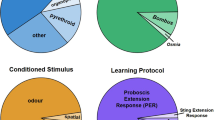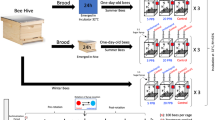Abstract
Animals develop food preferences based on taste, nutritional quality and to avoid environmental toxins. Yet, measuring preferences in an experimental setting can be challenging since ecologically realistic assays can be time consuming, while simplified assays may not capture natural sampling behavior. Field realism is a particular challenge when studying behavioral responses to environmental toxins in lab-based assays, given that toxins can themselves impact sampling behavior, masking our ability to detect preferences. We address these challenges by comparing different experimental methods for measuring sucrose concentration preference in bumble bees (Bombus impatiens), evaluating the utility of two preference chamber-based methods (ad libitum versus a novel restricted-sampling assay) in replicating bees’ preferences when they fly freely between artificial flowers in a foraging arena. We find that the restricted-sampling method matched a free-flying scenario more closely than the ad libitum protocol, and we advocate for expanded use of this approach, given its ease of implementation. We then performed a second experiment using the new protocol to ask whether consuming the neonicotinoid pesticide imidacloprid, known to suppress feeding motivation, interfered with the expression of sucrose preferences. After consuming imidacloprid, bees were less likely to choose the higher-quality sucrose even as they gained experience with both options. Thus, we provide evidence that pesticides interfere with bees’ ability to discriminate between floral rewards that differ in value. This work highlights a simple protocol for assessing realistic foraging preferences in bees and provides an efficient way for researchers to measure the impacts of anthropogenic factors on preference expression.




Similar content being viewed by others
References
Alkassab AT, Kirchner WH (2017) Sublethal exposure to neonicotinoids and related side effects on insect pollinators: honeybees, bumblebees, and solitary bees. J Plant Dis Prot 124:1–30. https://doi.org/10.1007/s41348-016-0041-0
Arce AN, Ramos Rodrigues A, Yu J et al (2018) Foraging bumblebees acquire a preference for neonicotinoid-treated food with prolonged exposure. Proc R Soc B Biol Sci 285:20180655. https://doi.org/10.1098/rspb.2018.0655
Asparch Y, Pontes G, Masagué S et al (2016) Kissing bugs can generalize and discriminate between different bitter compounds. J Physiol Paris 110:99–106. https://doi.org/10.1016/j.jphysparis.2016.11.006
Bates D, Mächler M, Bolker B, Walker S (2015) Fitting linear mixed-effects models using lme4. J Stat Softw. https://doi.org/10.18637/jss.v067.i01
Bell G, Lefebvre L, Giraldeau L-A, Weary D (1984) Partial preference of insects for the male flowers of an annual herb. Oecologia 64(3):287–294. https://doi.org/10.1007/BF00379123
Blacquière T, Smagghe G, van Gestel CAM, Mommaerts V (2012) Neonicotinoids in bees: a review on concentrations, side-effects and risk assessment. Ecotoxicology 21:973–992. https://doi.org/10.1007/s10646-012-0863-x
Bowers MA (1986) Resource availability and timing of reproduction in bumble bee colonies (Hymenoptera: Apidae). Environ Entomol 15:750–755. https://doi.org/10.1093/ee/15.3.750
Chesson J (1983) The estimation and analysis of preference and its relationship to foraging models. Ecology 64:1297–1304. https://doi.org/10.2307/1937838
Chittka L, Gumbert A, Kunze J (1997) Foraging dynamics of bumble bees: correlates of movements within and between plant species. Behav Ecol 8:239–249. https://doi.org/10.1093/beheco/8.3.239
Cnaani J, Thomson JD, Papaj DR (2006) Flower choice and learning in foraging bumblebees: effects of variation in nectar volume and concentration. Ethology 112:278–285. https://doi.org/10.1111/j.1439-0310.2006.01174.x
Crall JD, Switzer CM, Oppenheimer RL et al (2018) Neonicotinoid exposure disrupts bumblebee nest behavior, social networks, and thermoregulation. Science 362:683. https://doi.org/10.1126/science.aat1598
Démares FJ, Crous KL, Pirk CWW et al (2016) Sucrose sensitivity of honey bees is differently affected by dietary protein and a neonicotinoid pesticide. PLoS ONE 11:e0156584. https://doi.org/10.1371/journal.pone.0156584
Dunlap AS, Papaj DR, Dornhaus A (2017) Sampling and tracking a changing environment: persistence and reward in the foraging decisions of bumblebees. Interface Focus 7:20160149. https://doi.org/10.1098/rsfs.2016.0149
Goulson D (2013) An overview of the environmental risks posed by neonicotinoid insecticides. J Appl Ecol 50:977–987. https://doi.org/10.1111/1365-2664.12111
Goulson D, Cruise JL, Sparrow KR et al (2007) Choosing rewarding flowers; perceptual limitations and innate preferences influence decision making in bumblebees and honeybees. Behav Ecol Sociobiol 61:1523–1529. https://doi.org/10.1007/s00265-007-0384-4
Goulson D, Nicholls E, Botías C, Rotheray EL (2015) Bee declines driven by combined stress from parasites, pesticides, and lack of flowers. Science 347:1255957. https://doi.org/10.1126/science.1255957
Heinrich B (1976) The foraging specializations of individual bumblebees. Ecol Monogr 46:105–128. https://doi.org/10.2307/1942246
Herrera CM, Pérez R, Alonso C (2006) Extreme intraplant variation in nectar sugar composition in an insect-pollinated perennial herb. Am J Bot 93:575–581. https://doi.org/10.3732/ajb.93.4.575
Kessler SC, Tiedeken EJ, Simcock KL et al (2015) Bees prefer foods containing neonicotinoid pesticides. Nature 521:74–76. https://doi.org/10.1038/nature14414
Lambin M, Armengaud C, Raymond S, Gauthier M (2001) Imidacloprid-induced facilitation of the proboscis extension reflex habituation in the honeybee. Arch Insect Biochem Physiol 48:129–134. https://doi.org/10.1002/arch.1065
Lämsä J, Kuusela E, Tuomi J et al (2018) Low dose of neonicotinoid insecticide reduces foraging motivation of bumblebees. Proc R Soc B Biol Sci 285:20180506. https://doi.org/10.1098/rspb.2018.0506
Lanza J, Smith GC, Sack S, Cash A (1995) Variation in nectar volume and composition of Impatiens capensis at the individual, plant, and population levels. Oecologia 102:113–119
Leadbeater E, Chittka L (2007) Social learning in insects—from miniature brains to consensus building. Curr Biol 17:R703–R713. https://doi.org/10.1016/j.cub.2007.06.012
Levin DA (1972) Low frequency disadvantage in the exploitation of pollinators by corolla variants in Phlox. Am Nat 106:453–460
Lundin O, Rundlöf M, Smith HG, Fries I, Bommarco R (2015) Neonicotinoid insecticides and their impacts on bees: a systematic review of research approaches and identification of knowledge gaps. PLoS ONE 10(8):e0136928. https://doi.org/10.1371/journal.pone.0136928
Masek P, Scott K (2010) Limited taste discrimination in Drosophila. Proc Natl Acad Sci USA 107:14833. https://doi.org/10.1073/pnas.1009318107
Mogren CL, Lundgren JG (2016) Neonicotinoid-contaminated pollinator strips adjacent to cropland reduce honey bee nutritional status. Sci Rep 6:29608. https://doi.org/10.1038/srep29608
Mommaerts V, Wäckers F, Smagghe G (2013) Assessment of gustatory responses to different sugars in harnessed and free-moving bumblebee workers (Bombus terrestris). Chem Sen 38(5):399–407. https://doi.org/10.1093/chemse/bjt014
Muth F, Breslow PR, Masek P, Leonard AS (2018) A pollen fatty acid enhances learning and survival in bumblebees. Behav Ecol 29:1371–1379. https://doi.org/10.1093/beheco/ary111
Nachev V, Thomson JD, Winter Y (2013) The psychophysics of sugar concentration discrimination and contrast evaluation in bumblebees. Anim Cogn 16:417–427. https://doi.org/10.1007/s10071-012-0582-y
Nicolson SW, de Veer L, Köhler A, Pirk CWW (2013) Honeybees prefer warmer nectar and less viscous nectar, regardless of sugar concentration. Proc R Soc B Biol Sci 280:20131597. https://doi.org/10.1098/rspb.2013.1597
Palmer-Young EC, Calhoun AC, Mirzayeva A, Sadd BM (2018) Effects of the floral phytochemical eugenol on parasite evolution and bumble bee infection and preference. Sci Rep 8(1):1–11. https://doi.org/10.1038/s41598-018-20369-2
Perry G, Pianka ER (1997) Animal foraging: past, present and future. Trends Ecol Evol 12:360–364. https://doi.org/10.1016/S0169-5347(97)01097-5
Phelps JD, Strang CG, Gbylik-Sikorska M et al (2018) Imidacloprid slows the development of preference for rewarding food sources in bumblebees (Bombus impatiens). Ecotoxicology 27:175–187. https://doi.org/10.1007/s10646-017-1883-3
Pleasants JM (1989) Optimal foraging by nectarivores: a test of the marginal-value theorem. Am Nat 134:51–71. https://doi.org/10.1086/284965
Plowright CMS, Silverman A (2000) Nectar and pollen foraging by bumble bees (Hymenoptera: Apidae): choice and tradeoffs. Can Entomol 132:677–679. https://doi.org/10.4039/Ent132677-5
Pyke GH (1984) Optimal foraging theory: a critical review. Annu Rev Ecol Syst 15:523–575. https://doi.org/10.1146/annurev.es.15.110184.002515
R Core Team (2018) R: A language and environment for statistical computing. Version 3.5.0. R Foundation for Statistical Computing. Vienna. https://www.R-project.org/
Real L, Caraco T (1986) Risk and foraging in stochastic environments. Annu Rev Ecol Syst 17:371–390. https://doi.org/10.1146/annurev.es.17.110186.002103
Richardson LL, Adler LS, Leonard AS et al (2015) Secondary metabolites in floral nectar reduce parasite infections in bumblebees. Proc R Soc B Biol Sci 282:20142471. https://doi.org/10.1098/rspb.2014.2471
Richardson LL, Bowers MD, Irwin RE (2016) Nectar chemistry mediates the behavior of parasitized bees: consequences for plant fitness. Ecology 97:325–337. https://doi.org/10.1890/15-0263.1
Rotheray EL, Osborne JL, Goulson D (2017) Quantifying the food requirements and effects of food stress on bumble bee colony development. J Apic Res 56:288–299. https://doi.org/10.1080/00218839.2017.1307712
Samuelson EEW, Chen-Wishart ZP, Gill RJ, Leadbeater E (2016) Effect of acute pesticide exposure on bee spatial working memory using an analogue of the radial-arm maze. Sci Rep 6:38957. https://doi.org/10.1038/srep38957
Schaeffer RN, Mei YZ, Andicoechea J, Manson JS, Irwin RE (2017) Consequences of a nectar yeast for pollinator preference and performance. Funct Ecol 31(3):613-621. https://doi.org/10.1111/1365-2435.12762
Schiestl FP (2017) Innate receiver bias: its role in the ecology and evolution of plant–animal interactions. Annu Rev Ecol Evol Syst 48:585–603. https://doi.org/10.1146/annurev-ecolsys-110316-023039
Simpson SJ, Sibly RM, Lee KP et al (2004) Optimal foraging when regulating intake of multiple nutrients. Anim Behav 68:1299–1311. https://doi.org/10.1016/j.anbehav.2004.03.003
Smithson A, Macnair MR (1996) Frequency-dependent selection by pollinators: mechanisms and consequences with regard to behaviour of bumblebees Bombus terrestris (L.) (Hymenoptera: Apidae). J Evol Biol 9:571–588. https://doi.org/10.1046/j.1420-9101.1996.9050571.x
Sprayberry JDH, Ritter KA, Riffell JA (2013) The effect of olfactory exposure to non-insecticidal agrochemicals on bumblebee foraging behavior. PLoS ONE 8(10):e76273. https://doi.org/10.1371/journal.pone.0076273
Stanley DA, Russell AL, Morrison SJ et al (2016) Investigating the impacts of field-realistic exposure to a neonicotinoid pesticide on bumblebee foraging, homing ability and colony growth. J Appl Ecol 53:1440–1449. https://doi.org/10.1111/1365-2664.12689
Waddington KD (1995) Bumblebees do not respond to variance in nectar concentration. Ethology 101:33–38. https://doi.org/10.1111/j.1439-0310.1995.tb00342.x
Waddington KD (2001) Subjective evaluation and choice behavior by nectar-and pollen-collecting bees. Cognitive ecology of pollination. Cambridge University Press, Cambridge, pp 41–60
Willmer P (2011) Rewards 2: the biology of nectar. Pollination and floral ecology, Core Textbook. Princeton University Press, Princeton, pp 190–220
Woodard SH, Jha S (2017) Wild bee nutritional ecology: predicting pollinator population dynamics, movement, and services from floral resources. Curr Opin Insect Sci 21:83–90. https://doi.org/10.1016/j.cois.2017.05.011
Worden BD, Papaj DR (2005) Flower choice copying in bumblebees. Biol Lett 1(4):504–507. https://doi.org/10.1098/rsbl.2005.0368
Zimmerman M (1981) Optimal foraging, plant density and the marginal value theorem. Oecologia 49:148–153. https://doi.org/10.1007/BF00349181
Acknowledgements
The authors thank Koppert Biological Systems for bumble bee colonies, and T. Catlett, R. Dhami, J. Kailey, and S. Miller for assistance with experiments. We thank two anonymous reviewers for insightful comments on a previous version of the manuscript. Funding was provided by the United States Department of Agriculture (NIFA 2018-67014-27543) to ASL and US Department of Agriculture NIFA postdoctoral fellowship and a L’Oréal For Women in Science postdoctoral fellowship to FM.
Author information
Authors and Affiliations
Contributions
All authors conceived of the study and designed methodology. SR collected data. SR and FM analyzed data. SR led the writing of the manuscript. All authors contributed critically to drafts and gave final approval for publication.
Corresponding author
Additional information
Communicated by Diethart Matthies.
Supplementary Information
Below is the link to the electronic supplementary material.
Rights and permissions
About this article
Cite this article
Richman, S.K., Muth, F. & Leonard, A.S. Measuring foraging preferences in bumble bees: a comparison of popular laboratory methods and a test for sucrose preferences following neonicotinoid exposure. Oecologia 196, 963–976 (2021). https://doi.org/10.1007/s00442-021-04979-8
Received:
Accepted:
Published:
Issue Date:
DOI: https://doi.org/10.1007/s00442-021-04979-8




